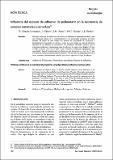Por favor, use este identificador para citar o enlazar a este item:
http://hdl.handle.net/10261/21185COMPARTIR / EXPORTAR:
 SHARE SHARE
 CORE
BASE CORE
BASE
|
|
| Visualizar otros formatos: MARC | Dublin Core | RDF | ORE | MODS | METS | DIDL | DATACITE | |

| Título: | Influencia del espesor de adhesivo de poliuretano en la resistencia de uniones sometidas a cortadura |
Otros títulos: | Thickness influence in mechanical properties of polyurethane adhesive overlap joints | Autor: | García Ledesma, R.; Oñoro, J.; Amo, José M. CSIC; Durán, M. C.; Durán, J. | Palabras clave: | Adhesivos Poliuretano Propiedades mecánicas Espesor de adhesivos Adhesive Polyurethane Mechanical properties Adhesive thickness |
Fecha de publicación: | 28-feb-2005 | Editor: | Consejo Superior de Investigaciones Científicas (España) | Citación: | Revista de Metalurgia 41(1): 60-65 (2005) | Resumen: | [ES] El espesor de la capa de adhesivo en las uniones por adhesión de materiales metálicos, tiene
una influencia notable en el comportamiento y las propiedades mecánicas de dichas
uniones. El objeto de este trabajo fue analizar las propiedades de resistencia y
desplazamiento, presentadas por uniones a solape de acero, unidas con capas de diferentes
espesores de un adhesivo de poliuretano. Los resultados obtenidos muestran que la
resistencia mecánica es máxima para capas de adhesivo de espesor muy delgado: 0,1 mm.
Cuando el espesor crece de 0,1 hasta 1 mm la resistencia disminuye rápidamente. Para
capas desde 1 hasta 1,5 mm la resistencia disminuye más lentamente y, a partir de 1,5 mm,
la resistencia permanece prácticamente constante. Por otro lado, los desplazamientos de la
unión aumentan uniformemente a medida que crece el espesor de la capa de adhesivo. [EN] The thickness of adhesive layers in metallic bonded joints has direct influence in the performance and mechanical behaviour of these joints. The aim of this study was to analyse the strength and strain properties of steel overlap joints bonded with polyurethane adhesive layers with different thickness. The results show that the strength is maximum when the thickness of the adhesive layer is very thin, 0.1 mm. When the thickness growth to 1 mm the strength goes down rapidly. For layers from 1 to 1.5 mm the strength goes down slower and from 1.5 to 4 mm the strength is nearly constant. In other hand, the joint strain increase uniformly with adhesive layer thickness growth. |
Descripción: | 6 páginas, 5 figuras.-- Nota técnica. | Versión del editor: | http://dx.doi.org/10.3989/revmetalm.2005.v41.i1.187 | URI: | http://hdl.handle.net/10261/21185 | DOI: | 10.3989/revmetalm.2005.v41.i1.187 | ISSN: | 0034-8570 | E-ISSN: | 1988-4222 |
| Aparece en las colecciones: | (CENIM) Artículos |
Ficheros en este ítem:
| Fichero | Descripción | Tamaño | Formato | |
|---|---|---|---|---|
| 187-193-1-PB.pdf | 313,15 kB | Adobe PDF |  Visualizar/Abrir |
CORE Recommender
SCOPUSTM
Citations
2
checked on 10-abr-2024
WEB OF SCIENCETM
Citations
3
checked on 21-feb-2024
Page view(s)
565
checked on 18-abr-2024
Download(s)
741
checked on 18-abr-2024
Google ScholarTM
Check
Altmetric
Altmetric
NOTA: Los ítems de Digital.CSIC están protegidos por copyright, con todos los derechos reservados, a menos que se indique lo contrario.
